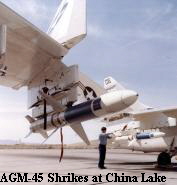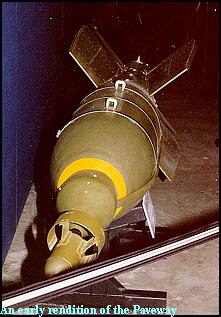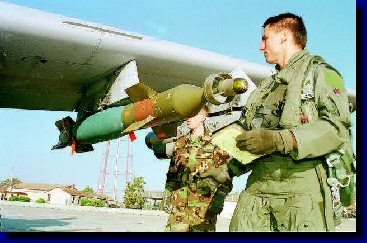|
"It was just a bunch of junk ..."
-- Weldon Word
The Army passed on the idea of a laser guided
Shrike, but the idea of using a laser didn't die with the theoretical laser
guided Shrike missile. A few engineers at Texas Instruments saw laser guidance
as a viable, low cost and ultimately light weight approach to guiding a bomb or
maybe an artillery shell.
Laser light is able to project a spot over
great distances and the beam of light stays tight. Unlike a flashlight beam
shined into the trees on a dark night. the laser beam doesn't scatter light
particles. Because the beam stayed tight, Word felt he could use it as
information to guide a weapon. Just after working on the Shrike study, While
working on TI systems at Eglin Air Force Base, Florida, Word discussed the issue
of bomb accuracy with U.S . Air Force Colonel Joe Davis who as the deputy base
commander was in charge of weapons ranges at Eglin. . Air Force Colonel Joe Davis who as the deputy base
commander was in charge of weapons ranges at Eglin.
"Joe wanted to find a
way to help our guys over in Southeast Asia get their bombs right on the target.
Now, he wasn't in the bomb development business, but Joe knew there was a
problem, and he wanted to find and answer," Word said.
Blazing through
heavy ground fire and flak was normal for most bomb runs throughout Southeast
Asia. Many World War II veterans who flew in the war remembered the flak being
more intense in some spots of North Vietnam than it had been in heavily
defended sections of Germany two decades earlier. Since most aircrews didn't
want to end up with jets shattered by exploding anti aircraft fire, they jinked
to avoid it, thus spoiling the aim of their bombs.
Pulling out a picture
of the Than Hoa Bridge out of a desk drawer, the Eglin colonel showed Word where
the problem was, Word remembers. "I started counting craters in that photo. I
stopped when I got to 800 or so, and I never did finish." Davis told Word he
wanted a weapon that could be released around 10,000 feet and then "fly" the
rest of the way to the target with a large enough warhead that one or two bombs
would destroy even the hardiest of targets. Giving the issue some thought, Word
and other engineers at TI figured a beam of laser light could be used as a bomb
guidance system. The Shrike studies had been promising, but when the TI
engineers broached the idea with anybody at Eglin but Colonel Davis it was as if
a Hollywood producer had walked into the room wanting to make a teleplay out of
the latest science fiction novel. "They would just laugh at us and think we
were nuts," Word recalled. There were those within TI who thought lasers were a
far fetched dream, too. "Many people just thought it was crazy. There were a
lot of detractors -- military and within TI -- who said this can't be done," TI
engineer Nick Baker said.
A few months after seeing the photo of the Than
Hoa Bridge, Word had almost given up on using a laser guidance system when Davis
stoked again the fires of development. "On a Friday morning in early June of
'65, we mentioned to Joe Davis that no one else at Eglin feels the Air Force
has a bombing problem," Word recalls. "Col. Joe explodes. Then he says, 'Have
a proposal on my desk by 8 a.m. Monday and I will fund it. It has to be for a
dozen guided bombs that have a thirty foot delivery accuracy and, of by the way,
it needs to be fixed price for less than $100,000 and the schedule has to be six
months for delivery and flight test.' "
Over that weekend the Word
embarked on a marathon, sleepless 72-hour development session. By Monday, the
end result was an 18-page hand written proposal for a laser guided bomb
development program which he felt could deliver a bomb that could come within
thirty feet of a target; the program was projected to cost $99,000, with a six
month delivery schedule. "Later it turned out to be nothing like what we
produced. I mean we just had a seeker device basically nailed onto a stabilizer.
There was no way it would have flown," Word said. "It was just a bunch of junk,
but that's where we laid the ground work was in that original proposal."
Word made the deadline, and while he waited on the Eglin military and civilian
officials to butt heads over his proposal, the Texas Instruments engineer
grabbed a six pack of beer and headed to the nearest beach. "We were told to get
lost for a few hours, so I headed to the beach," he said. On paper, the concept
was convincing to Colonel Joe Davis who sent the proposal straight to
Wright-Patterson Air Force Base, Ohio, home of Air Force research and
development projects. Within a few days, the idea made its way to the Limited
Warfare Office at Wright Patterson and landed on director Jack Short's desk.
The office had a program where defense contractors could come up with ideas for
improved weapons or war material such as better tent pegs, ponchos or radio
equipment. A good idea would net a company $100,000 in seed, or development,
money and if it worked maybe a lucrative government contract to build the
product.
After a severe lobbying campaign from Davis and Word, the office
signed off on the project, giving the TI team $100,000 in development funds.
The team had six months to develop a device which for the military would change
the way bombing accuracy was defined. Their task was to get the bomb within 30
feet of the target. This would beat the average bomb accuracy of the day,
which ranged from 100-1,000 feet depending on the tactics, the target and the
weather.
"I don't think we knew what we were building at first -- not in
terms of the scope of the program. Certainly, we didn't envision this would
become what it has today in terms of accuracy and reliability, " Nick Baker
offered. "We just wanted to find a way to guide a bomb. Nobody really thought it
would be as accurate as it was."
"It was unlike any other development program anyone had ever seen,"
--
Weldon Word
A lthough the bomb may appear simple in
design today -- bolt a guidance seeker on the front and control fins on the rear
of a standard bomb casing -- in the fall of 1965 it was anything but easy. Word
and his fellow engineers identified the problems they would have to conquer in a
short time. First, the team had to develop and build a seeker which would sense
the laser light, and then figure a way to move that information to the Shrike
control unit bolted on the end of the bomb. Finally, they had to make it fly --
the bomb had to be aerodynamic.
"It was unlike any other development
program anyone had ever seen," Word says today. "We had so little time and there
was a heck of a lot of improvising. One problem would crop up, we would solve
it, and then another three would be waiting. You had to move fast."
Most of the work was adapting and improving missile
technology, but Tom Weaver remembered one of the most significant challenges the
TI team faced was electronically moving the guidance data from the seeker to the
control unit in an era of transistors and circuit breadboards. "We faced the
problem that this had never been tried before. It wasn't so much (developing)
the laser, as it was working with that slow data rate we had to guide on. It
was only like eight or ten pulses per second. And as far as data rates go
that's very slow when you are talking about a bomb falling through the air to a
target some 6,000 to 8,000 feet away," Weaver said. "That data rate problem was
one of the biggest challenges to get past." The team finally locked in 10
pulses per second as the golden number for a bomb to guide to the target.
Working out of TI's labs in Dallas, Texas, and trudging down to the
steamy, jungle like ranges of Eglin Air Force Base, Florida, the team set about
to make laser guided bombs a reality in September 1965. With only six months to
design, test and prove laser guidance, the pressure of the ticking clock brought
on a fast paced, sometimes unorthodox development cycle for the guided bomb. The
TI engineers didn't know how to use a laser, having never seen a working model.
Salonimer loaned them a laser, one of only two in the world, and they used the
water tower in Plano, Texas as a fixed object to measure laser light
return.
Continue to "Development"
|
|















